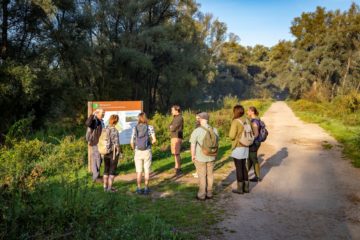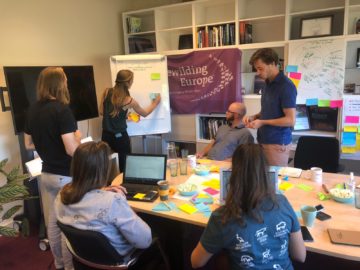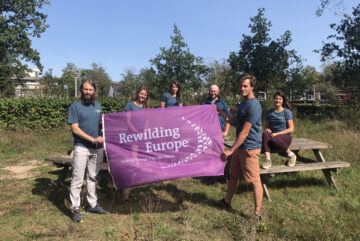Engaging and empowering young people is vital to the growth of rewilding. This is why Rewilding Europe is starting up the new Young Rewilders Community.

Influential demographic
With its positive message and emphasis on practical conservation, rewilding is playing an increasingly important role connecting younger generations with nature. In its mission to make Europe a wilder place, Rewilding Europe wants to inspire the next generation of European conservationists to help restore the natural world.
Bringing innovation, intelligence, drive and a fresh perspective, young people have enormous potential to influence policy, business and science across the world.
“The younger generation is increasingly demanding a different future, where people co-exist with nature and natural systems allow communities to prosper,” says 24-year-old Aleksandrina Mitseva, who joined Rewilding Europe’s Supervisory Board in 2019 and is currently studying for a master’s degree in biology at Aarhus University in Denmark.
Early career expansion

With a view to building on and enhancing that connection, Rewilding Europe began advertising for an additional “early-career” supervisory board member in early 2019. After a number of interviews, Aleksandrina Mitseva was appointed to the board in May. Over a year later, she remains thrilled with her position.
“It’s a really rewarding, give-and-take process,” she explains. “I contribute my insight, energy and understanding of young people’s perspectives to the governance and strategic development of Rewilding Europe. And I am also working to engage more young Europeans in rewilding, and support them in their efforts.”
Community creation

Working together with Laurien Holtjer, Rewilding Europe’s Head of Communications, one of Aleksandrina’s first actions was to create a Young Rewilders Community (YRC).
“The ubiquity of social media is allowing a new generation to reach out and connect with others who share their interests in the environment and wild nature,” explains Mitseva. “A core objective of the community is to provide younger people with an online platform for exchange, which is why we’ve set up user groups on Slack and Facebook.”
The YRC now numbers around 30 people, all aged between 20 and 30, from across Europe. Of these, five are core team members, involved in community organisation, grants and media production. The remainder act as ambassadors, spreading the message about rewilding and contributing to discussions.
Milestone meeting
In September 2020, the core team of the YRC held a five-day meeting in the Dutch city of Nijmegen, the location of Rewilding Europe’s headquarters. After many months of online interaction, it was the first time that team members had met face-to-face.
“It was an inspirational, eye-opening experience which really taught me a lot,” says Charles Dimiaux, a 26-year-old Belgian who is currently studying for a master’s degree in marine biology. “The outside-of-the-box thinking, the creative solutions, the entrepreneurship and the positive and pragmatic approach to nature recovery made me realise how much rewilding and Rewilding Europe have to offer. And at the end of the five days, it really felt like we had bonded as a team.”
Experiencing rewilding at work

Accompanied by Wouter Helmer, Rewilding Europe’s Senior Rewilding Advisor, the YRC group spent one day visiting the Millingerwaard area, located just outside Nijmegen on the River Waal (part of the River Rhine). This showcase rewilding initiative, which started as far back as 1993 as a pilot of the far larger Gelderse Poort project, demonstrates perfectly how both people and wild nature can benefit when natural processes are given free rein to reshape landscapes.
The team also visited the Maashorst Nature Reserve in the southeastern Dutch province of Noord-Brabant, which is home to herds of Tauros, European bison and Exmoor ponies. Representatives of the Taurus Foundation, a partner of Rewilding Europe, showed the group how these animals are helping to transform degraded agricultural land into a more biodiversity-rich, half-open mosaic landscape through their grazing.
Next steps

The Nijmegen visit also saw the YRC establish goals and plans for the future. In addition to Wouter Helmer, the team also met Rewilding Europe Managing Director Frans Schepers and pitched an impromptu presentation to him outlining their vision for the way ahead.
“We thought long and hard about what the YRC can bring to rewilding and Rewilding Europe,” says Aleksandrina Mitseva. “We want to create a wilder Europe by uniting young professionals and enthusiasts. Through the creation of a network where members are provided with tools, we will inspire them to become active players in the rewilding movement.”
A preliminary online YRC platform is scheduled for launch next June, when everyone who is interested can join and sign up for a regular newsletter. This will eventually be developed into a full platform providing young people with rewilding-related resources and access to regular webinars.
Inspirational appeal

Despite headlines about digital device addiction and a lack of time spent outside, the story of young people and wild nature is not all doom and gloom. What unites the members of the Young Rewilder Community, apart from their youth, passion and enthusiasm, is the inspirational appeal of rewilding.
“Rewilding is new, it’s optimistic, and it has the potential to work at scale,” says core team member Rhys Lemoine, a 24-year-old Canadian master’s student based in Dublin. “The opportunity to do something big and bold is very attractive to a generation that’s grown up on environmental pessimism.”
“The biodiversity crisis and the climate emergency are huge societal challenges that are simply overwhelming for many people, both young and old,” adds Charles Dimiaux. “Rewilding offers hope because it can deliver immediate, practical, nature-based solutions to these challenges. And that hope can really motivate young people to connect with nature and work towards a better future.”
Want to know more?
Parts of this news item were taken from a story in the Rewilding Europe Annual Review 2019 entitled “Next generation”. A PDF of the full story can be downloaded here.
